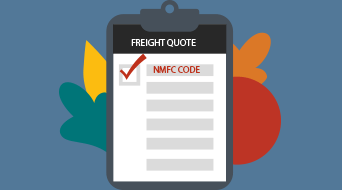Determine Your Freight Shipment's NMFC Class & Code
What is the NMFC number? How do you determine the freight class? And, how does density factor into it all? Avoid additional shipping fees and become a smarter business-savvy shipper.
Understanding Freight Classifications
Determining the correct National Motor Freight Classification (NMFC) class and code is crucial for shipping goods efficiently and cost-effectively. The NMFC system categorizes freight into classes based on various factors such as density, stowability, handling and liability. Proper classification ensures that you are billed correctly and helps prevent delays and disputes with carriers. Here's a detailed guide to help you navigate this process!
What is NMFC?
The National Motor Freight Classification (NMFC) is a standard used in the U.S. for freight shipping. Developed by the National Motor Freight Traffic Association (NMFTA), the NMFC system classifies freight into 18 different classes, ranging from 50 to 500. Each class corresponds to a specific rate that carriers use to calculate shipping costs. The classification considers various characteristics of the freight, including its density, value and ease of handling.
Key Factors Affecting NMFC Classification
To determine the correct NMFC class and code, consider the following factors:
1. Density
Density is a major factor in determining freight class. It is calculated by dividing the weight of the shipment by its volume (weight per cubic foot). Higher density shipments generally fall into lower classes (i.e., they are less expensive to ship) because they are easier to handle and stow. Conversely, lower density shipments are assigned higher classes due to their larger space requirements and handling challenges.
2. Stowability
Stowability refers to how well the freight can be stored and stacked during transit. Goods that are easy to stow and do not shift or cause damage are classified lower. Items that are awkwardly shaped or require special handling might fall into a higher class due to the increased risk and complexity involved in storing and securing them.
3. Handling
Handling involves the amount of effort required to load, unload and move the freight. Items that are fragile, require special equipment, or are hazardous typically fall into a higher NMFC class due to the additional care needed during handling. Conversely, goods that are robust and easy to handle are classified lower.
4. Liability
Liability pertains to the risk associated with the freight. High-value or easily damaged items are considered riskier and are assigned a higher class. This ensures that carriers are compensated for the potential costs associated with loss or damage. Lower liability items, which are less valuable or more durable, are classified in a lower category.
Steps to Determine NMFC Class and Code
1. Gather Information
Collect all relevant details about your shipment. This includes dimensions, weight, and a description of the item. Understanding the nature of the freight—whether it is dense, fragile, or hazardous—will help in accurately classifying it.
2. Measure and Weigh
Measure the dimensions of your shipment and calculate its cubic volume. Weigh the shipment accurately to determine its density. For example, if a shipment weighs 100 pounds and occupies 10 cubic feet, the density would be 10 pounds per cubic foot. Use this information to narrow down potential NMFC classes.
3. Review the NMFC Directory
Access the NMFC directory, which is available through the NMFTA or various logistics and transportation resources. This directory lists all the NMFC classes and codes along with descriptions and criteria. Locate your shipment's category based on its characteristics.
4. Match Characteristics
Compare the characteristics of your shipment—density, stowability, handling and liability—with the descriptions provided in the NMFC directory. For instance, if your shipment is a high-density, easily stowable item with minimal handling requirements, it might fall into a lower NMFC class. On the other hand, if it is bulky, fragile, and requires special handling, it will likely fall into a higher class.
5. Consult with Your Carrier or 3PL
If you are unsure about the classification, consult with your carrier or a third-party logistics provider (3PL). Carriers and 3PLs are experienced in handling various types of shipments and can provide guidance on the correct NMFC class. They can also help ensure that your shipment is classified correctly to avoid unexpected charges or delays.
6. Verify and Document
Once you have determined the NMFC class and code, document this information and verify it with your carrier. Accurate documentation helps prevent disputes and ensures that billing is processed correctly. Keep a record of the classification for future reference, especially if you frequently ship similar items.
Need help with freight codes and class? Unishippers is here!
Determining your freight shipment's NMFC class and code is a critical step in ensuring efficient and cost-effective shipping. By understanding the factors that influence NMFC classification and following the outlined steps, you can accurately categorize your freight and avoid common pitfalls. Proper classification not only facilitates smoother transactions but also helps maintain good relationships with carriers and avoids unnecessary costs.
Need help with freight classification? Contact Unishippers today for a free consultation.



